Probably everyone remembers drawing pictures as a child with a round red featureless Sun in the top right of the page. A closer look at the Sun's surface, however, reveals that it is packed with intricate granular patterns. These dots that appear and disappear every five to 10 minutes are shedding light on a long-standing mystery regarding the nature of the Sun.
The Sun in art

Tower of the Sun, Taro Okamoto, 1970
Courtesy of Taro Okamoto Memorial Foundation for Contemporary Art
Since time immemorial the Sun has been worshipped as a god. In old Japan, the sun was worshipped as the sun goddess Amaterasu. Although there was some variation between different nations and regions, the Sun god was seen as a tempestuous and fearsome presence rather than a gentle being. Hard as it is to imagine nowadays, in ancient Mexico many people's lives were sacrificed as offerings to the Sun god.
The artist Taro Okamoto, who enjoyed great success in Japan during its economic boom, is said to have been strongly influenced by the Sun-worship ceremonies of the Aztecs of ancient Mexico. He first learnt about these when he went to France in his twenties to study in Paris. Okamoto, who was captivated by vivid reds from his boyhood, subsequently produced many works that either used reds that evoked blood or had the Sun as their theme.
"Ever since I was a small child, I always loved reds. Not bright, cheerful, care-free reds, however, but tempestuous reds that evoked blood. ... I had the impulse to dye my whole body red. I have always felt that this blood red itself is evocative of life and that this is my color."
Bino juryoku by Taro Okamoto
(The quotes are original Nikon translations)
Many of the works of Okamoto—who asserts that "Art should not be 'beautiful'," "Art is an explosion!"—enable us to re-examine the origins of humanity. His work may also be attributable to the fact that the Sun is an entity which cannot be ignored when relating human history.
Naturally, the Sun has not only an effect on the Earth's climate; it also has a major influence on human activity- for example, explosions known as Sun flares emit high-energy particles to which astronauts could be exposed, and they affect the condition of the ionosphere, disrupting radio communications.
There are still many unknowns, such as how sunspots are formed, how sun flares occur, and how the rarefied plasma known as the corona that surrounds the Sun acquires energy. Intense research into these unknowns is underway.
Black footprints on the Sun
Have you ever seen sunspots? As the name suggests, sunspots are areas on the Sun that appear as black spots, like moles. In ancient China it was said that there were black crows living on the Sun. Galileo Galilei was the first person to observe sunspots through a telescope. Since then, there have been many recorded sightings throughout human history, and these have proved useful in tracking solar activity.
Sunspots are an indicator of the Sun's degree of activity. Many people have probably heard it said that the Sun is relatively inactive, as there are currently few sunspots. What then are these sunspots?
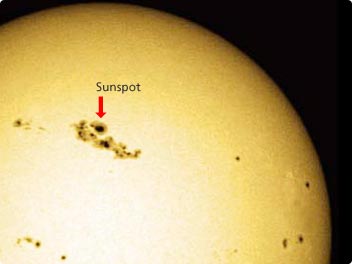
Sunspot
©NAOJ/JAXA
First, the reason why sunspots appear to be black is that they are lower in temperature than the surrounding areas. The temperature of the surface of the Sun is as high as 6,000 ºC; however, the black sunspot areas are believed to be cooler, with temperatures in the region of 4,000 ºC. Why are the black sunspot areas lower in temperature? This can only be explained in terms of what is taking place inside the Sun.
Vast amounts of energy are generated in the Sun's core. The Sun consists of a number of layers- just like an onion. The energy that is generated in the core reaches the so-called convection zone at the Sun's surface through the so-called radiation zone, which encloses the core. In 2006, high-resolution images that showed the surface of the Sun came through from the satellite Hinode. The situation around the sunspots is extremely interesting, and is worth taking a closer look at. The surface (granules), on which the grains around the sunspots are tightly arrayed, is boiling due to the heat from below. In contrast, this is not the situation in the black sunspot areas. This is because powerful lines of magnetic force are emitted from the sunspots, preventing the convection that occurs outside the sunspots from taking place. This is why the temperature of the sunspots does not reach the same high levels as the areas around the sunspots.
Images of the periphery of a sunspot taken by the solar observation satellite Hinode. The way in which matter flows into and out of the sunspot due to the lines of magnetic force that emanate from the sunspot is revealed. The peripheral dots are called granules, and they can be seen coming to a boil.
©NAOJ/JAXA
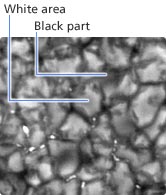
Granules. The white areas are parts that have risen to the surface from the interior. The black parts are parts that are sinking down.
©NAOJ/JAXA
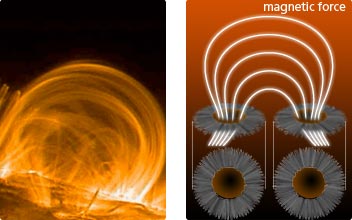
Two neighboring sunspots serve as a giant magnet, with the lines of magnetic force extending up and out from the Sun's surface. Plasma can be seen glittering along these lines of magnetic force.
©NAOJ/JAXA
Observed using visible light, the sunspots appear dark. When observations are carried out using X-rays, however, it is the corona vertically above the sunspots that shines the brightest. In X-ray images of the Sun, the sunspot areas can be clearly and distinctly identified from the corona vertically above them.

X-ray photograph of the Sun
©NAOJ/JAXA
Small magnetic fields that envelop the Sun
In her time as a graduate student at the University of Tokyo, Ryoko Ishikawa has been conducting research into the vertical magnetic flux lines (or vertical magnetic fields) that extend up and out from the surface of the Sun. She chose this research theme while a third-year undergraduate at Kyoto University, after being shown images of the Sun. There is a great deal that is still not known about the Sun and she became interested in it because it is such a familiar part of our lives.
It was known that around sunspots there were magnetic fields perpendicular to the surface of the Sun that extended upwards. However, the images that were sent back by the satellite Hinode in 2007 revealed hitherto undiscovered horizontal magnetic fields all over the surface of the Sun.
The lifespan of these small horizontal magnetic fields is interconnected with the dots that boil up on the surface of the Sun, and which appear and disappear every five to ten minutes. It was realized that these magnetic fields were emanating from the surface of the Sun in accord with the flow of matter coming to a boil.
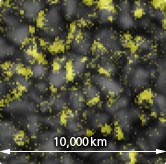
The yellow granule areas are strong horizontal magnetic fields.
©NAOJ/JAXA
The mechanism behind these horizontal magnetic fields, which have short lifespans and physical lengths (first discovered in 2007), has yet to be discovered. Ms. Ishikawa, who is in the vanguard of this research, believes that there are two possibilities. One is that the horizontal magnetic fields are formed out of the magnetic fields generated by the sunspots. The other is that the numerous magnetic fields appearing on the surface are representative of the magnetic fields generated when convection of matter takes place on the surface. From any standpoint, the latter possibility is the more convincing.
This is because horizontal magnetic fields at the edges of sunspots and horizontal magnetic fields at a distance from sunspots are generated at roughly the same frequency. This will probably provide the opportunity to solve a major long-standing mystery surrounding the Sun, as explained below.
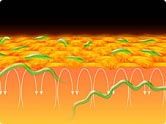
Countless magnetic fields standing out on the surface of the Sun
©NAOJ/JAXA
Why the outer layers of the Sun are hotter than the source of the heat
While the surface of the Sun has a temperature of around 6,000 ºC, the zone above the surface (known as the chromosphere) is at 10,000 ºC and the zone above this (known as the corona) is at 1,000,000 ºC. In simple terms, it is like the lid of a saucepan (which is much further away from the flame) becoming hotter than the base of the pan. This has been a great mystery to Sun researchers.
Why would the recent discovery of horizontal magnetic fields lead to the resolution of this problem? The explanation lies in the fact that if the energy needed to raise the temperature of the upper corona to 1,000,000 ºC is calculated, it corresponds to exactly the amount of energy that would be emitted if the entire surface of the Sun were enveloped in horizontal magnetic fields. Although the individual magnetic fields are small, the amount of energy produced is vast. Ms. Ishikawa believes that this energy may be the energy source that is heating up the corona.
Although the Sun is so close by and sunspots have been known of since olden times, the mechanism behind them is still in the process of being revealed. How will a new image of the Sun affect us?
 ©NAOJ/JAXA
©NAOJ/JAXA
Cooperation on materials / Date of article posted
Ryoko Ishikawa, doctoral candidate in astronomy, Graduate School of Science, University of Tokyo / April 2010

